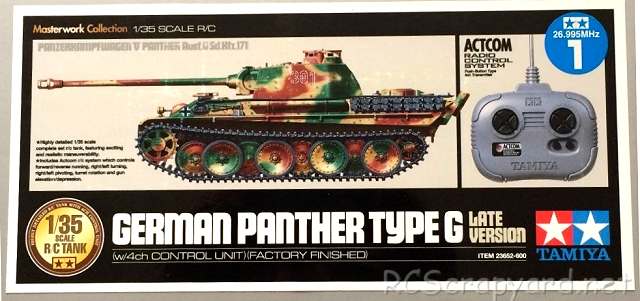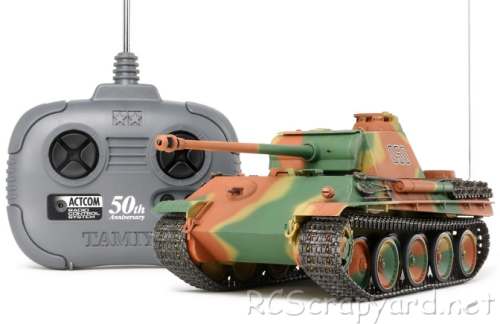

|


|
Tamiya German Panther Type G - RTR - # 23652
|
Released by Tamiya on September 30, 2010, the 1/35 R/C German Panther Type G Late Version (# 23652) came Factory Finished with a 4-channel radio system.

At the beginning of WWII, German tanks were defeated by Russian T-34 medium tanks and in order to counter them, Germany created the Panther V and were deployed to frontlines in 1943. It featured excellent defensive abilities, had sloped armour plates, powered by a 700ps Maybach HL230P30 4-stroke V12 gasoline engine which provided them with a top speed of 55km/h.
It was armed with a 70 calibre 7.5cm long barrelled tank gun which was as powerful as the Tiger It's 8.8cm gun. Evolved from the Type D and A, the Panther Type G was put into production from March 1944.
Later in 1944, the Type G received more extensive modifications which included an angle-bottomed gun mantled, exhausts with flame dampers and heater units on top of the engine grilles. Overall 2,953 Panther Gs were produced until the final factory was captured by Allied forces in April 1945. The Panther G went on to serve as Germany's main battle tank until the end of the war.
This model comes with metal bushings, that after a short while, when dust and grit get into them, can actually wear into the metal drive shafts that spin in them - we recommend these should be replaced by a full set of steel shielded ball bearings ASAP.








|
|
|

|

|
Hints, Tips and Information
How to avoid Radio Interference
1/ The first consideration when installing your Receiver into your Electrically Powered Model is to make sure it is well away from the Negative Battery terminal, and the Motor. The Magnetic field can cause stuttering type interference at times of high current draw (i.e., Fast Acceleration) |









|






|
|
|
|
Hints, Tips and Information
Servos for RC Models
Servos are found on all kinds of Radio Controlled Models. RC Touring Cars, Buggys, Trucks, Truggys, Monster Trucks, Rock Crawlers, Airplanes, Helicopters, Boats and Ships for Steering, Throttle Control, Rudder Operation and Wing Flaps. |
|
Hints, Tips and Information
Radio Frequencies - be Careful be Safe
After buying your first car, it won't be long before you need more than simply bashing around the back yard, or out on the street. So you will be looking around to find a club that is not too far away where you can do some serious racing. |
|
RC Models:
|
Radio & Motors: |
Other
Accessories: |